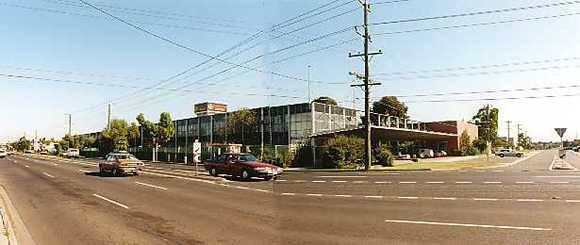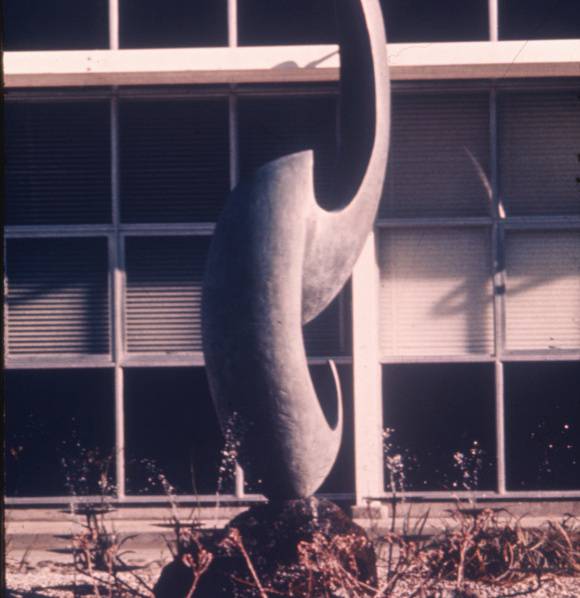| Back to search results » | Back to search page » |
|
Eta Factory & Teisutis Zikaras Sculpture
Location254 Ballarat Road,, BRAYBROOK VIC 3019 - Property No B5435
File NumberB5435LevelState |
|
Statement of Significance
PUBLIC ART STATEMENT OF SIGNIFICANCE
Contemporary Australian sculptors received very few commissions in the 1950s and only a very limited number in the 1960s. A commission for a sculpture and fountain for a new factory building, such as the Eta (peanut butter) Factory was indeed extremely rare at this time. Teisutis Zikaras had only carried out three previous commissions, the most significant being a series of decorative cast concrete screens for the balustrade on the first floor, north side on Union House, University of Melbourne in 1958. (since removed, some reused on western side of building)
The Eta Factory, designed by Frederick Romberg of Grounds Romberg and Boyd is an excellent example of modernist design in Melbourne and is well worthy of classification. The factory building faces onto Ballarat Road, but at the rear a garden was established for the use of staff (this can be seen from side street). Included in the garden design was a rock pool with central fountain. At the time this would have seemed extravagant use of space and a generous attitude towards factory staff.
The sculpture consists of two cast concrete sections of similar curving forms, placed one above the other in a delicate sense of balance. The emphasis is on the upward sweep of the organic forms, which spring from the rugged stability of the basalt boulder at the base. The sculpture is placed in a circular concrete basin filled with water and edged with basalt pitchers. Four Copper discs on opposite sides of the work were meant to direct water onto the sculpture, but are no longer in working order.
Two years after the Eta fountain was installed, Zikaras completed another commission (probably his last commissioned work) which was also a fountain, through lack of maintenance the fine jets of water soon failed to work and the bronze was simply viewed as a piece of sculpture. This work was orignally designed for the small public square at the northern end of the Melbourne GPO, but was removed several years later and spent many years in storage before being rescued by Simon Klose (then Director of Mc Clelland Gallery). After restoration at Meridian Foundry it was placed outside the Frankston Cultural Centre.
Of the two fountains designed by Zikaras only the Eta Factory work is in its original position.
Classified: 10/11/1998
ETA FACTORY STATEMENT OF SIGNIFICANCE
The ETA Factory, is an important work by Frederick Romberg, of the famous partnership Grounds, Romberg and Boyd. It was completed in 1961 and is of architectural and historical importance at the State level.
Architecturally, the factory is remarkably stylish and slick modernist design, belying its industrial function. It is an excellent example of a curtain wall design expressing a structural rationalism common with other important examples of this period in Melbourne. It is important for its featurist conception of the facade as billboard. The long curtain wall of the administration block facing Ballarat Road, with its brooding black vitrolite panels, is given added dynamism by the arrow-like diagonal bracing (originally finished in gold) that were used to lead the eye to supergraphic signage. The carpark / entry canopy is daringly wide, supported by an innovative cable structure tied back into the building and the ground of the courtyard. Other structural innovations include the tubular steel roof trusses designed with engineer John Connell.
The original landscape, designed by John Stevens, was a significant example of an early modernist garden, rare in Australia. It included areas of river pebbles in dramatic zigzag patterns and succulent plantings, some of which survive. He also designed the courtyard garden, with an abstract sculpture / fountain by Teisutis (Joe) Zikaris, which is separately classified.
Historically, the factory was part of the great surge in construction of manufacturing establishments in the 1950s, mostly in the then outer suburbs, which were part of the great economic boom of the post war period. The optimism of the period and the central position of manufacturing, is reflected in the use of a prominent modernist architect to produce a striking design for the factory headquarters of an Australian company.
The ETA factory had some international prominence. It was the only Australian design included in the 1962 publication Industriebau, a seminal international text on industrial design, published by the German Institute for Industry.
Classified: 02/10/2000
Group
Manufacturing and Processing
Category
Factory/ Plant





